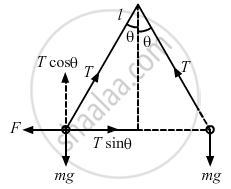Advertisements
Advertisements
प्रश्न
Two small spheres, each with a mass of 20 g, are suspended from a common point by two insulating strings of length 40 cm each. The spheres are identically charged and the separation between the balls at equilibrium is found to be 4 cm. Find the charge on each sphere.
उत्तर

Tcosθ = mg ...(i)
Tsinθ = Fe ...(ii)
Here,
\[F_e = \frac{1}{4 \pi\epsilon_0}\frac{q^2}{r^2}\]
\[\tan\theta = \frac{2}{39 . 9}\]
Dividing equation (ii) by (i), we get
\[\tan\theta = \frac{F_e}{\text{ mg }}\]
\[ \Rightarrow \tan\theta = \frac{1}{4 \pi\epsilon_0}\frac{q^2}{r^2} . \frac{1}{\text{mg}}\]
\[ \Rightarrow q^2 = \frac{\tan\theta . r^2 . \text{mg}}{1/4 \pi\epsilon_0}\]
\[ \Rightarrow q^2 = 17 \times {10}^{- 16} \]
\[ \Rightarrow q = 4 . 123 \times {10}^{- 8} C\]
APPEARS IN
संबंधित प्रश्न
The electrostatic force on a small sphere of charge 0.4 μC due to another small sphere of charge − 0.8 μC in air is 0.2 N.
- What is the distance between the two spheres?
- What is the force on the second sphere due to the first?
Three-point charges q, – 4q and 2q are placed at the vertices of an equilateral triangle ABC of side 'l' as shown in the figure. Obtain the expression for the magnitude of the resultant electric force acting on the charge q

(b) Find out the amount of the work done to separate the charges at infinite distance.
Four charges +q, −q, +q and −q are to be arranged respectively at the four corners of a square ABCD of side 'a'.
(a) Find the work required to put together this arrangement.
(b) A charge q0 is brought to the centre of the square, the four charges being held fixed. How much extra work is needed to do this ?
One end of a 10 cm long silk thread is fixed to a large vertical surface of a charged non-conducting plate and the other end is fastened to a small ball of mass 10 g and a charge of 4.0× 10-6 C. In equilibrium, the thread makes an angle of 60° with the vertical. Find the surface charge density on the plate.
Two charges 2.0 × 10−6 C and 1.0 × 10−6 C are placed at a separation of 10 cm. Where should a third charge be placed, such that it experiences no net force due to these charges?
Two charged particles are placed 1.0 cm apart. What is the minimum possible magnitude of the electric force acting on each charge?
Find the ratio of the electrical and gravitational forces between two protons.
Two charged particles with charge 2.0 × 10−8 C each are joined by an insulating string of length 1 m and the system is kept on a smooth horizontal table. Find the tension in the string.
Two identical balls, each with a charge of 2.00 × 10−7 C and a mass of 100 g, are suspended from a common point by two insulating strings, each 50 cm long. The balls are held at a separation 5.0 cm apart and then released. Find.
(a) the electric force on one of the charged balls
(b) the components of the resultant force on it along and perpendicular to the string
(c) the tension in the string
(d) the acceleration of one of the balls. Answers are to be obtained only for the instant just after the release.
A particle A with a charge of 2.0 × 10−6 C and a mass of 100 g is placed at the bottom of a smooth inclined plane of inclination 30°. Where should another particle B, with the same charge and mass, be placed on the incline so that it may remain in equilibrium?
Two particles A and B, each carrying a charge Q, are held fixed with a separation dbetween them. A particle C of mass m and charge q is kept at the middle point of the line AB. Assuming x<<d, show that this force is proportional to x.
Two identical particles, each with a charge of 2.0 × 10−4 C and mass of 10 g, are kept at a separation of 10 cm and then released. What would be the speed of the particles when the separation becomes large?
Define a unit charge.
Write down Coulomb’s law in vector form and mention what each term represents.
What are the differences between the Coulomb force and the gravitational force?
Polarised dielectric is equivalent to ______.
Electric charge of any system is ______.
According to Coulomb's law, which is the correct relation for the following figure?

What is meant by the statement: "Relative permittivity of water is 81"?
